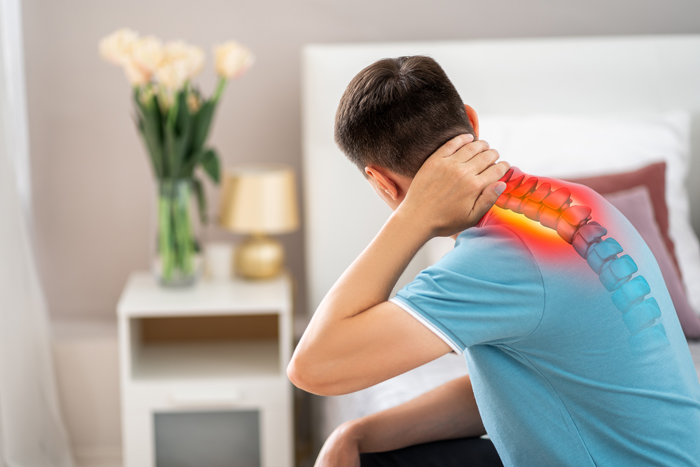Cervical Spondylosis Treatment in Chembur, Mumbai
Cervical spondylosis is a common aging disorder that affects the joints and discs of your cervical spine in the neck. It is sometimes called cervical osteoarthritis or arthritis of the neck. It originates from cartilage and bone wear and tear. Although it is usually the effect of aging, it can also be due to other factors.

What are the Symptoms of Cervical Spondylosis?
The majority of patients have no cervical spondylosis symptoms. However, pain and stiffness in the neck commonly occur as symptoms arise.
- Tingling, tangling, and weakening in arms, hands, legs, or feet.
- Lack of coordination and problems in walking.
- Bowel or bladder control loss.
Underlying Causes of Cervical Spondylosis
As you age, your backbone and neck gradually acquire wear and tear in bones and cartilages. The following changes may occur:
- Discs are dehydrated: Discs behave as cushions between the spinal vertebras. By age 40, most spinal disks start to dry up and shrink, which allows for increased bone-on-bone contact between the vertebras. Age also affects your backbone's exterior. A crack appears regularly, resulting in bulging disks – sometimes pressing the spinal cord and nerve roots.
- Bone spurs: These are the consequence of the body trying to make the spine stronger by growing more bones. However, the excess bone can press sensitive spinal parts, such as the spinal cord and nerves, resulting in pain.
- Injury: If you have suffered a neck injury (for example, after a fall or car accident), it might accelerate the aging process.
When to See a Doctor?
Search for a back pain specialist near you if you see a rapid onset of numbness, weakness, or bladder or bowel control loss.
You can request an appointment at Apollo Spectra Hospitals, Chembur, Mumbai.
Call 1860 500 2244 to book an appointment.
Are There Any Risk Factors That Contribute to Cervical Spondylosis?
- Age is the specific aspect of cervical spondylosis.
- Occupations with frequent neck motions bring extra stress to your neck.
- Injuries to the neck increase the likelihood of cervical spondylosis.
- Genetical issues (family history of cervical spondylosis).
- Smoking is associated with more significant pain in the neck.
Are There Any Possible Complications?
If the cervical spondylosis significantly compresses your spinal cord and nerve roots, the damage may be lifelong.
What are the Available Treatments?
The seriousness of your indications and symptoms determines the treatment of cervical spondylosis. The treatments aim to ease pain, maintain your everyday activities, and avoid permanent damage to the spinal cord and nerves.
Medicines
If over-the-counter pain medicines are not adequate, your doctor might prescribe:
- Anti-inflammatory anti-steroidal medicine to treat the pain and inflammation.
- A short course of a Corticosteroid drug like oral prednisone might help relieve discomfort. Steroid injections might be helpful if your pain is severe.
- Some medications, such as cyclobenzaprine, can help to alleviate muscle spasms in the neck.
- Some anti-seizure medications, such as gabapentin (Neurontin, Horizant) and Pregabalin (Lyrica), can reduce pain in the nerves.
- Some antidepressants have been proven to relieve pain in the neck.
Therapy
A physical therapist may teach you workouts to help stretch out your neck and shoulders and strengthen their muscles. In addition, some persons suffering from cervical spondylosis benefit from traction that can contribute to reducing space in the vertebras by pinching nerve roots.
Surgery
If conservative therapy fails, or your neurological signs and symptoms increase – like weakness in your arms or legs – you may require surgery that might include:
- Removal of a herniated disk or bone spurs
- Removal of the vertebra part
- Fusion of a neck section with bone graft and hardware
Lifestyle remedies
Mild cervical spondylosis may be reactive to:
- Regular exercise.
- Maintaining activity will assist hasten to heal, even if some of your workouts need to be temporarily changed due to neck pain. For example, people who walk every day are less likely to have pain in the neck and back.
- Over-the-counter pain relievers
- Often enough, Ibuprofen (Advil, Motrin IB, others), naproxen sodium (Aleve), or acetaminophen (Tylenol, others) is sufficient to manage cervical spondylosis-related pain.
- Heat or ice
- Heat or ice can easily be applied to your neck.
- Comfortable neck brace
- The brace can relax your neck muscles. However, the neck brace should only be used for short durations, as it might gradually weaken muscles in the neck.
Request an appointment at Apollo Spectra Hospitals, Chembur, Mumbai.
Call 1860 500 1066 to book an appointment.
Conclusion:
Cervical Spondylosis is a common complaint among aging individuals and is caused by wear and tear of the bones and cartilage. Physiotherapy and medications can help in mild cases, but severe cases may require surgery. It is better to consult a doctor if you experience pain in the neck area to take timely treatment.
According to Cleveland Clinic, more than 90% of adults aged 60 and older are affected by this condition.
Many people can perform typical everyday activities despite cervical spondylosis.
Your doctor will determine the course of treatment depending on your symptoms. Mild cases may only need medications and/or therapy.


.svg)
.svg)
.svg)
.svg)









